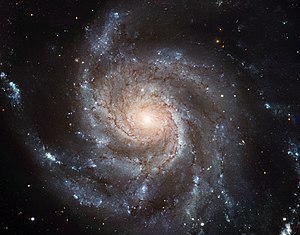Messier Index/M101
| Pinwheel Galaxy | |
|---|---|
 | |
| Observation data (w:J2000 epoch) | |
| Constellation | w:Ursa Major[1] |
| Right ascension | 14h 03m 12.6s[2] |
| Declination | +54° 20′ 57″[2] |
| Redshift | 241 ± 2 km/s[2] |
| Distance | 27 Mly[citation needed] |
| Type | SAB(rs)cd[2] |
| Apparent dimensions (V) | 28′.8 × 26′.9[2] |
| Apparent magnitude (V) | 8.3[2] |
| Other designations | |
| Messier 101,[2] NGC 5457,[2] UGC 8981,[2] PGC 50063,[2] Arp 26[2] | |
The Pinwheel Galaxy (also known as Messier 101 or NGC 5457) is a face-on w:spiral galaxy about 27 million w:light-years away in the w:constellation w:Ursa Major.
It was discovered by w:Pierre Méchain on w:March 27, w:1781, and he subsequently communicated his discovery to w:Charles Messier who verified its position and added it to the w:Messier Catalogue as one of the final entries.
On w:February 28, w:2006, w:NASA and the w:ESA released a very detailed image of Pinwheel Galaxy, which was the largest and most detailed image of a galaxy by w:Hubble Space Telescope at the time.[3] The image was composed from 51 individual exposures, plus some extra ground-based photos.
Discovery
Pierre Méchain, the discoverer of M101, described it as a "nebula without star, very obscure and pretty large, 6' to 7' in diameter, between the left hand of Bootes and the tail of the great Bear. It is difficult to distinguish when one lits the [grating] wires."[4]
w:William Herschel noted in 1784 that "[M101] in my 7, 10, and 20-feet reflectors shewed a mottled kind of nebulosity, which I shall call resolvable; so that I expect my present telescope will, perhaps, render the stars visible of which I suppose them to be composed."[4]
w:Lord Rosse observed M101 in his 72-inch Newtonian reflector during the second half of the 19th century. He was the first to make extensive note of the spiral structure and made several sketches.[4]
To observe the spiral structure in modern instruments requires a fairly large instrument, very dark skies, and a low power eye piece.
Structure and composition

M101 is a relatively large galaxy compared to the w:Milky Way. With a diameter of 170,000 light-years it is nearly twice the size of the Milky Way. It has a disk mass on the order of 100 billion solar masses, along with a small bulge of about 3 billion solar masses[5]
Another remarkable property of this galaxy is its huge and extremely bright H II regions , of which a total of about 3000 can be seen on photographs. HII regions usually accompany the enormous clouds of high density molecular hydrogen gas contracting under their own gravitational force where stars form. HII regions are ionized by large numbers of extremely bright and hot young stars.
On photographs M101 can be seen to be asymmetrical on one side. It is thought that in the recent past (speaking in galactic terms) M101 underwent a near collision with another galaxy and the associated gravitational w:tidal forces caused the asymmetry. In addition, this encounter also amplified the density waves in the spiral arms of M101. The amplification of these waves leads to the compression of the interstellar hydrogen gas, which then triggers strong w:star formation activity.
Companion galaxies
M101 has five prominent companion galaxies: w:NGC 5204, w:NGC 5474, w:NGC 5477, w:NGC 5585, and w:Holmberg IV.[6] As stated above, the gravitational interaction between M101 and its satellites may have triggered the formation of the grand design pattern in M101. M101 has also probably distorted the companion galaxy NGC 5474.[6] M101 and its companion galaxies comprise most or possibly all of the w:M101 Group.[7][8][9][10]
External links
- Messier 101, SEDS Messier pages
- Extremely detailed picture of the Pinwheel Galaxy at HubbleSite.org
- Pinwheel Galaxy at ESA/Hubble
- Spiral Galaxy Messier 101 (Pinwheel Galaxy)
- Picture of the day on APOD on april 14th 2009
References
- ↑ R. W. Sinnott, editor (1988). The Complete New General Catalogue and Index Catalogue of Nebulae and Star Clusters by J. L. E. Dreyer. Sky Publishing Corporation and Cambridge University Press. ISBN 0-933-34651-4.
{{cite book}}:|author=has generic name (help) - ↑ a b c d e f g h i j k "NASA/IPAC Extragalactic Database". Results for NGC 5457. Retrieved 2006-12-06.
- ↑ HubbleSite - NewsCenter - Hubble's Largest Galaxy Portrait Offers a New High-Definition View (02/28/2006) - Introduction
- ↑ a b c SEDS Historical Notes, [1]
- ↑ Comte, G., Monnet, G., & Rosado, M. "An optical study of the galaxy M 101 - Derivation of a mass model from the kinematic of the gas," 1979, Astronomy & Astrophysics, 72, 73-81 ([2])
- ↑ a b A. Sandage, J. Bedke (1994). Carnegie Atlas of Galaxies. Washington, D.C.: Carnegie Institution of Washington. ISBN 0-87279-667-1.
- ↑ R. B. Tully (1988). Nearby Galaxies Catalog. Cambridge: Cambridge University Press. ISBN 0-521-35299-1.
- ↑ P. Fouque, E. Gourgoulhon, P. Chamaraux, G. Paturel (1992). "Groups of galaxies within 80 Mpc. II - The catalogue of groups and group members". Astronomy and Astrophysics Supplement. 93: 211–233.
{{cite journal}}: CS1 maint: multiple names: authors list (link) - ↑ A. Garcia (1993). "General study of group membership. II - Determination of nearby groups". Astronomy and Astrophysics Supplement. 100: 47–90.
- ↑ G. Giuricin, C. Marinoni, L. Ceriani, A. Pisani (2000). "Nearby Optical Galaxies: Selection of the Sample and Identification of Groups". Astrophysical Journal. 543: 178–194. doi:10.1086/317070.
{{cite journal}}: CS1 maint: multiple names: authors list (link)